engine YAMAHA YXZ1000R SS 2017 Owner's Manual
[x] Cancel search | Manufacturer: YAMAHA, Model Year: 2017, Model line: YXZ1000R SS, Model: YAMAHA YXZ1000R SS 2017Pages: 208, PDF Size: 4.79 MB
Page 84 of 208
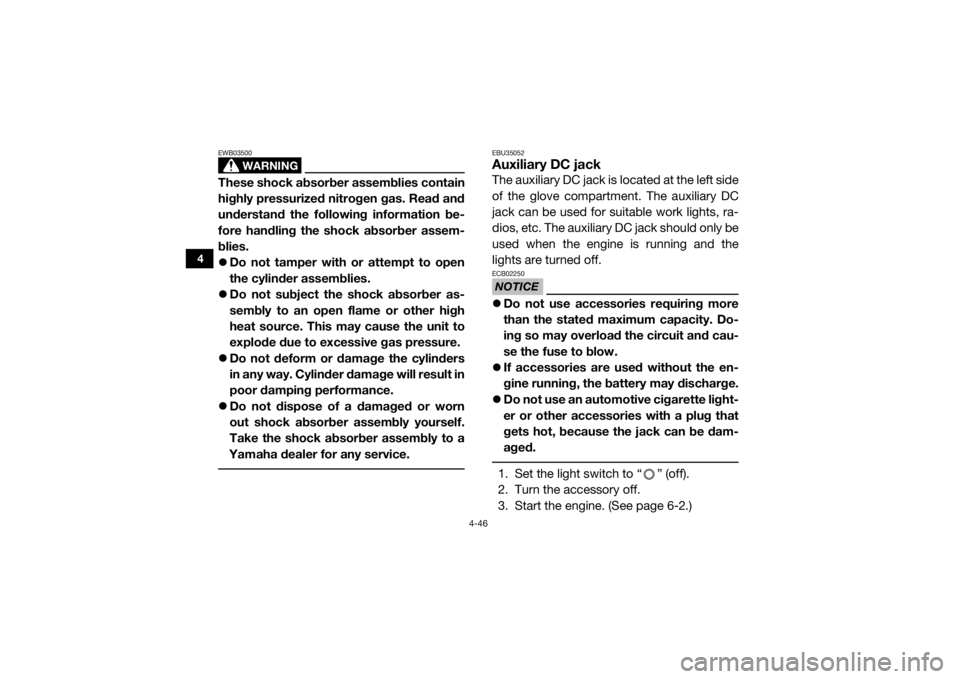
4-46
4
WARNING
EWB03500These shock absorber assemblies contain
highly pressurized nitrogen gas. Read and
understand the following information be-
fore handling the shock absorber assem-
blies.
Do not tamper with or attempt to open
the cylinder assemblies.
Do not subject the shock absorber as-
sembly to an open flame or other high
heat source. This may cause the unit to
explode due to excessive gas pressure.
Do not deform or damage the cylinders
in any way. Cylinder damage will result in
poor damping performance.
Do not dispose of a damaged or worn
out shock absorber assembly yourself.
Take the shock absorber assembly to a
Yamaha dealer for any service.
EBU35052Auxiliary DC jackThe auxiliary DC jack is located at the left side
of the glove compartment. The auxiliary DC
jack can be used for suitable work lights, ra-
dios, etc. The auxiliary DC jack should only be
used when the engine is running and the
lights are turned off.NOTICEECB02250 Do not use accessories requiring more
than the stated maximum capacity. Do-
ing so may overload the circuit and cau-
se the fuse to blow.
If accessories are used without the en-
gine running, the battery may discharge.
Do not use an automotive cigarette light-
er or other accessories with a plug that
gets hot, because the jack can be dam-
aged. 1. Set the light switch to “ ” (off).
2. Turn the accessory off.
3. Start the engine. (See page 6-2.)
U2HC7ME0.book Page 46 Tuesday, April 19, 2016 10:33 AM
Page 87 of 208

5-2
5
Engine oil• Check oil level.
• Fill with oil to proper level if necessary.
5-5, 8-15
Drivetrain • Check front differential, transmission case, and rear final
gear for leakage. 5-6, 5-6, 5-7, 8-26,
8-29, 8-31
Coolant • Check coolant level in reservoir.
• Fill with coolant if necessary. 5-6, 8-33
Accelerator pedal • Check free play and for proper operation. 5-7
Seat belts • Check for proper operation and belt wear. 5-7
Passenger handhold • Check for stability and proper fastening. 5-7, 7-8
Steering • Check for proper operation. 5-7
Shift lever • Check for proper operation. 5-8
Fittings and fasteners • Check all fittings and fasteners. 5-8
Instruments, lights and
switches • Check operation, and correct if necessary.
5-8, 8-63, 8-64
Wheels and tires • Check tire pressure and for wear and damage. 5-8, 8-54, 8-56
Axle boots • Check for damage. 8-35
ITEM
ROUTINE PAGE
U2HC7ME0.book Page 2 Tuesday, April 19, 2016 10:33 AM
Page 89 of 208
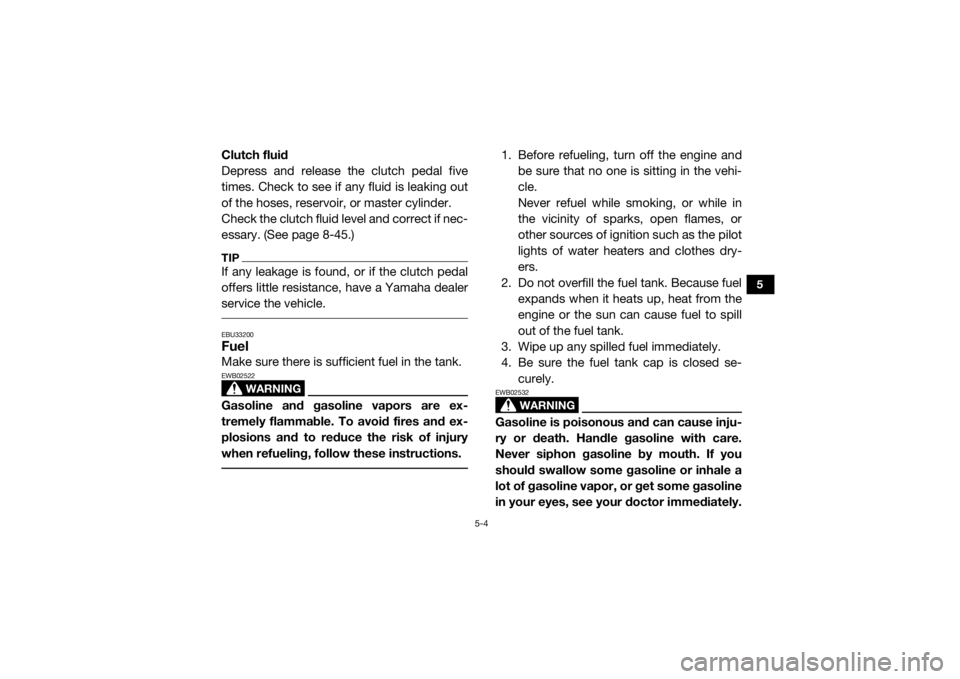
5-4
5
Clutch fluid
Depress and release the clutch pedal five
times. Check to see if any fluid is leaking out
of the hoses, reservoir, or master cylinder.
Check the clutch fluid level and correct if nec-
essary. (See page 8-45.)TIPIf any leakage is found, or if the clutch pedal
offers little resistance, have a Yamaha dealer
service the vehicle. EBU33200FuelMake sure there is sufficient fuel in the tank.
WARNING
EWB02522Gasoline and gasoline vapors are ex-
tremely flammable. To avoid fires and ex-
plosions and to reduce the risk of injury
when refueling, follow these instructions.
1. Before refueling, turn off the engine and
be sure that no one is sitting in the vehi-
cle.
Never refuel while smoking, or while in
the vicinity of sparks, open flames, or
other sources of ignition such as the pilot
lights of water heaters and clothes dry-
ers.
2. Do not overfill the fuel tank. Because fuel expands when it heats up, heat from the
engine or the sun can cause fuel to spill
out of the fuel tank.
3. Wipe up any spilled fuel immediately.
4. Be sure the fuel tank cap is closed se- curely.
WARNING
EWB02532Gasoline is poisonous and can cause inju-
ry or death. Handle gasoline with care.
Never siphon gasoline by mouth. If you
should swallow some gasoline or inhale a
lot of gasoline vapor, or get some gasoline
in your eyes, see your doctor immediately.
U2HC7ME0.book Page 4 Tuesday, April 19, 2016 10:33 AM
Page 90 of 208

5-5
5
If gasoline spills on your skin, wash with
soap and water. If gasoline spills on your
clothing, change your clothes. Your Yamaha engine has been designed to
use regular unleaded gasoline with a research
octane number of 91 or higher (95 or higher
for Europe). If knocking or pinging occurs,
use a different brand of gasoline or premium
unleaded gasoline. Unleaded fuel will give
you longer spark plug life and reduced main-
tenance cost.Portable fuel containers
If you carry a portable fuel container in the
bed of your Yamaha YXZ1000R, be sure to
secure it with the cap tightened before driving
the vehicle.
Always place a portable fuel container on the
ground before filling it. Before removing the
container cap, touch the container with the
fuel dispenser nozzle. Keep fuel dispenser
nozzle in contact with container inlet when fill-
ing.
WARNING! Never refill a fuel container
in the bed of any vehicle. Fire may result
from a build-up of static electricity. The
discharge of this build-up while refueling
can cause a spark and ignite the gasoline.
[EWB03270]
EBU35680Engine oilMake sure the engine oil is at the specified
level. Add oil as necessary. (See page 8-15.)
Recommended fuel: Regular unleaded gasoline only
For Europe: Regular unleaded gasoline only
with a research octane number of 95 or
higher
Fuel tank capacity: 34.0 L (8.98 US gal, 7.48 Imp.gal)
U2HC7ME0.book Page 5 Tuesday, April 19, 2016 10:33 AM
Page 91 of 208
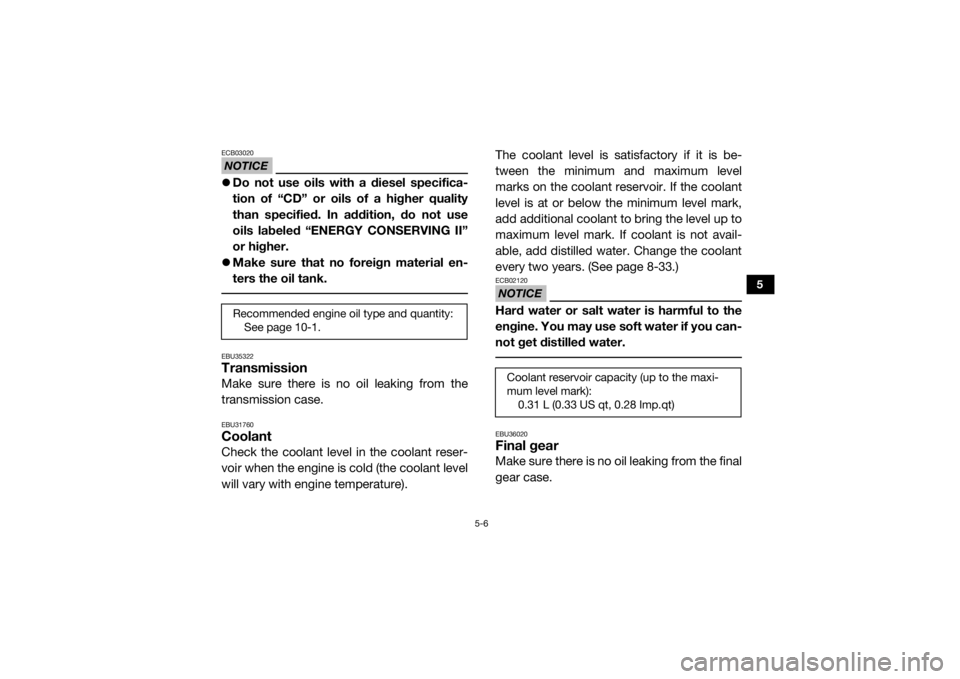
5-6
5
NOTICEECB03020Do not use oils with a diesel specifica-
tion of “CD” or oils of a higher quality
than specified. In addition, do not use
oils labeled “ENE RGY CONSERVING II”
or higher.
Make sure that no foreign material en-
ters the oil tank. EBU35322TransmissionMake sure there is no oil leaking from the
transmission case.EBU31760CoolantCheck the coolant level in the coolant reser-
voir when the engine is cold (the coolant level
will vary with engine temperature). The coolant level is satisfactory if it is be-
tween the minimum and maximum level
marks on the coolant reservoir. If the coolant
level is at or below the minimum level mark,
add additional coolant to bring the level up to
maximum level mark. If coolant is not avail-
able, add distilled water. Change the coolant
every two years. (See page 8-33.)
NOTICEECB02120Hard water or salt water is harmful to the
engine. You may use soft water if you can-
not get distilled water. EBU36020Final gearMake sure there is no oil leaking from the final
gear case.
Recommended engine oil type and quantity:
See page 10-1.
Coolant reservoir capacity (up to the maxi-
mum level mark):0.31 L (0.33 US qt, 0.28 Imp.qt)
U2HC7ME0.book Page 6 Tuesday, April 19, 2016 10:33 AM
Page 93 of 208

5-8
5
EBU35690Shift leverThe shift lever should move smoothly both
forward and backwards and return to its orig-
inal position after a gear change is made.
Check the shift lever and transmission for
roughness before starting off.TIPThe engine may need to be started for the
transmission to engage gears. EBU35700Fittings and fastenersAlways check the tightness of chassis and
wheel fittings and fasteners before starting
off. Take the vehicle to a Yamaha dealer or re-
fer to the Service Manual for correct tighten-
ing torque.EBU31840Instruments, lights and switchesCheck that all instruments, lights and switch-
es are working properly. Correct if necessary.
EBU31851Control cablesWhen driving in cold weather, always make
sure all control cables work smoothly before
starting off. WARNING! Control cables can
freeze in cold weather and you could be
unable to control the vehicle.
[EWB03280]
EBU35331
TiresCheck tire pressure regularly to make sure it
is at the recommended specifications. Also
check for wear and damage.
Tire pressure
Use the tire pressure gauge to check and ad-
just tire pressures when the tires are cold. Tire
pressures must be equal on both sides.
WARNING! Operation of this vehicle with improper tire pressure may cause severe
injury or death from loss of control or roll-
over. Tire pressure below the minimum
U2HC7ME0.book Page 8 Tuesday, April 19, 2016 10:33 AM
Page 96 of 208
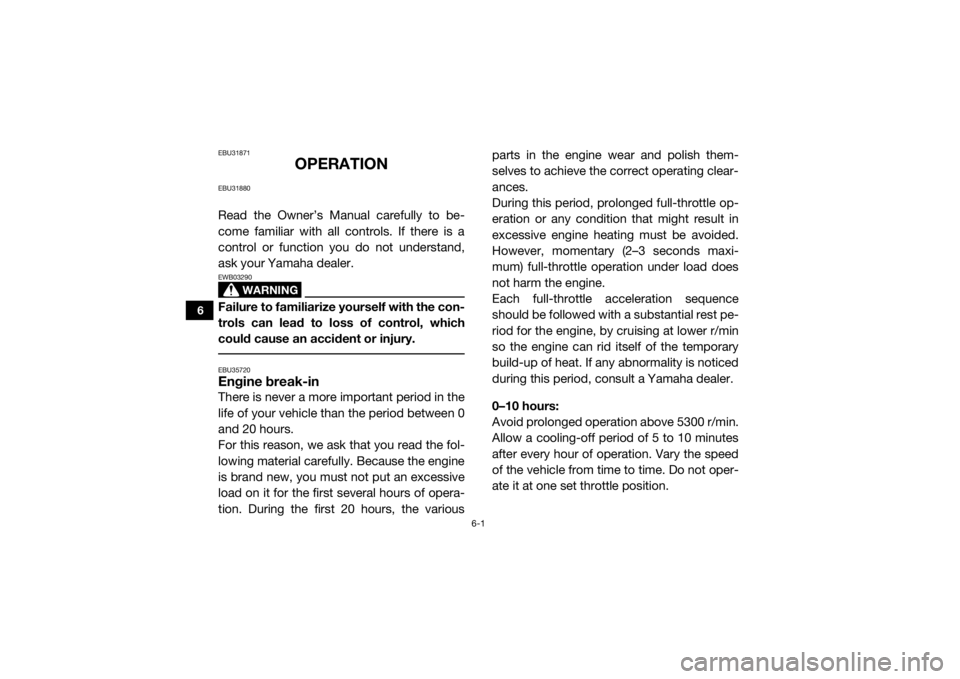
6-1
6
EBU31871
OPERATION
EBU31880Read the Owner’s Manual carefully to be-
come familiar with all controls. If there is a
control or function you do not understand,
ask your Yamaha dealer.
WARNING
EWB03290Failure to familiarize yourself with the con-
trols can lead to loss of control, which
could cause an accident or injury. EBU35720Engine break-inThere is never a more important period in the
life of your vehicle than the period between 0
and 20 hours.
For this reason, we ask that you read the fol-
lowing material carefully. Because the engine
is brand new, you must not put an excessive
load on it for the first several hours of opera-
tion. During the first 20 hours, the variousparts in the engine wear and polish them-
selves to achieve the correct operating clear-
ances.
During this period, prolonged full-throttle op-
eration or any condition that might result in
excessive engine heating must be avoided.
However, momentary (2–3 seconds maxi-
mum) full-throttle operation under load does
not harm the engine.
Each full-throttle acceleration sequence
should be followed with a substantial rest pe-
riod for the engine, by cruising at lower r/min
so the engine can rid itself of the temporary
build-up of heat. If any abnormality is noticed
during this period, consult a Yamaha dealer.
0–10 hours:
Avoid prolonged operation above 5300 r/min.
Allow a cooling-off period of 5 to 10 minutes
after every hour of operation. Vary the speed
of the vehicle from time to time. Do not oper-
ate it at one set throttle position.U2HC7ME0.book Page 1 Tuesday, April 19, 2016 10:33 AM
Page 97 of 208
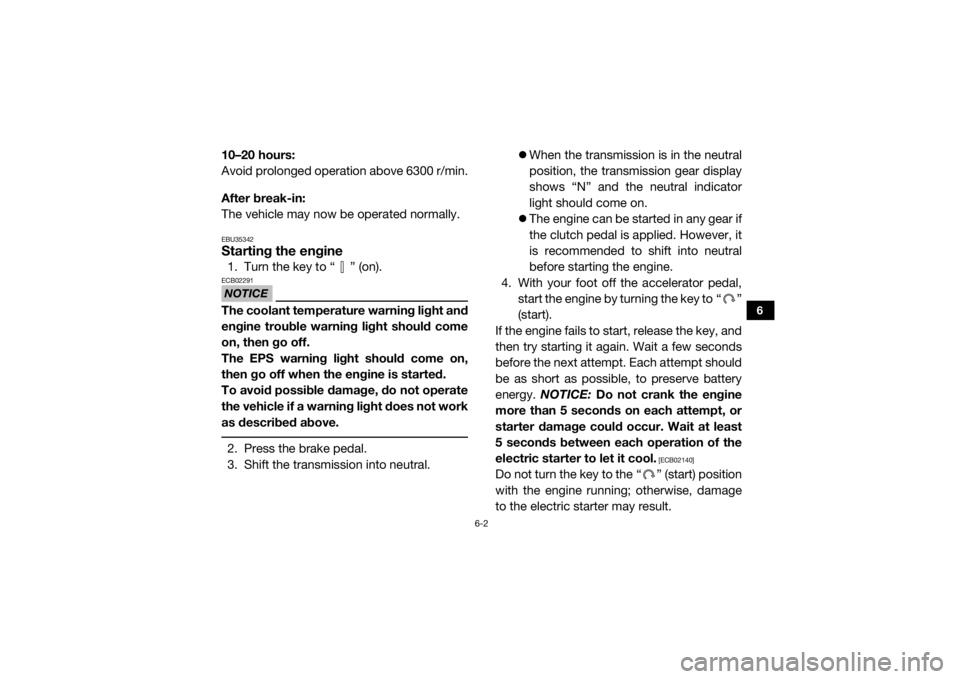
6-2
6
10–20 hours:
Avoid prolonged operation above 6300 r/min.
After break-in:
The vehicle may now be operated normally.EBU35342Starting the engine1. Turn the key to “ ” (on).NOTICEECB02291The coolant temperature warning light and
engine trouble warning light should come
on, then go off.
The EPS warning light should come on,
then go off when the engine is started.
To avoid possible damage, do not operate
the vehicle if a warning light does not work
as described above. 2. Press the brake pedal.
3. Shift the transmission into neutral.
When the transmission is in the neutral
position, the transmission gear display
shows “N” and the neutral indicator
light should come on.
The engine can be started in any gear if
the clutch pedal is applied. However, it
is recommended to shift into neutral
before starting the engine.
4. With your foot off the accelerator pedal, start the engine by turning the key to “ ”
(start).
If the engine fails to start, release the key, and
then try starting it again. Wait a few seconds
before the next attempt. Each attempt should
be as short as possible, to preserve battery
energy. NOTICE: Do not crank the engine
more than 5 seconds on each attempt, or
starter damage could occur. Wait at least
5 seconds between each operation of the
electric starter to let it cool.
[ECB02140]
Do not turn the key to the “ ” (start) position
with the engine running; otherwise, damage
to the electric starter may result.
U2HC7ME0.book Page 2 Tuesday, April 19, 2016 10:33 AM
Page 98 of 208
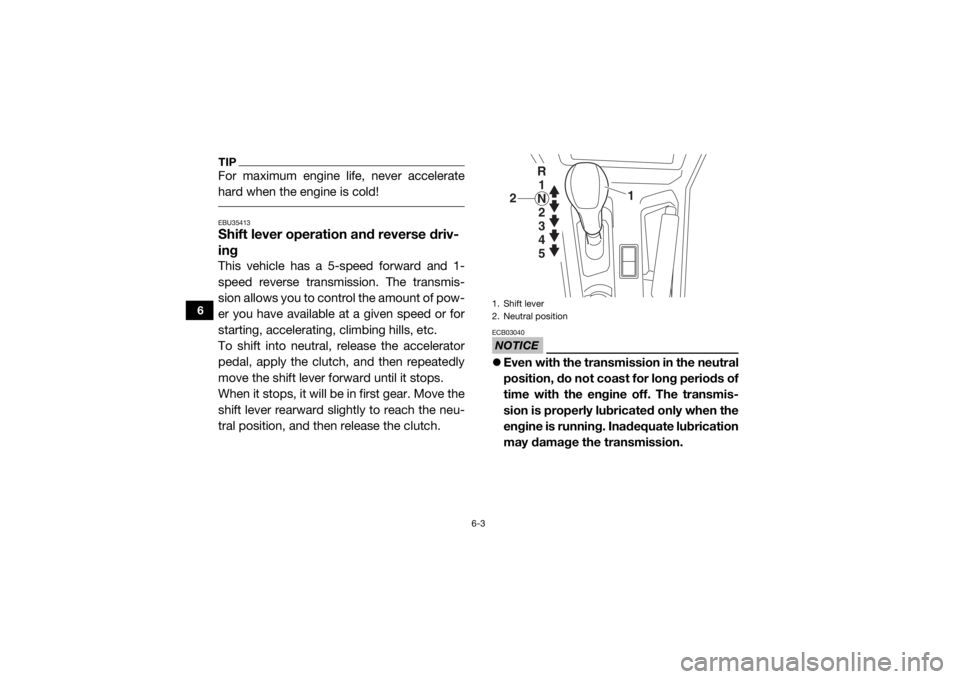
6-3
6
TIPFor maximum engine life, never accelerate
hard when the engine is cold! EBU35413Shift lever operation and reverse driv-
ingThis vehicle has a 5-speed forward and 1-
speed reverse transmission. The transmis-
sion allows you to control the amount of pow-
er you have available at a given speed or for
starting, accelerating, climbing hills, etc.
To shift into neutral, release the accelerator
pedal, apply the clutch, and then repeatedly
move the shift lever forward until it stops.
When it stops, it will be in first gear. Move the
shift lever rearward slightly to reach the neu-
tral position, and then release the clutch.
NOTICEECB03040 Even with the transmission in the neutral
position, do not coast for long periods of
time with the engine off. The transmis-
sion is properly lubri cated only when the
engine is running. Inadequate lubrication
may damage the transmission.1. Shift lever
2. Neutral position
1
2
R 1
N 2
3
4
5
U2HC7ME0.book Page 3 Tuesday, April 19, 2016 10:33 AM
Page 99 of 208

6-4
6
Always use the clutch when changing
gears. The engine and drivetrain are not
designed to withstand the shock of
forced shifting and can be damaged by
shifting without using the clutch. To start out and accelerate
1. Take your foot off the accelerator pedal,
apply the brake, and then release the
parking brake if applied. NOTICE: Al-
ways take your foot off the accelerator
pedal before shifting gears, otherwise
damage to the engine and drivetrain
may result.
[ECB02930]
2. Press the clutch pedal to disengage the
clutch.
3. Shift into first gear by moving the shift le-
ver forward. (The transmission gear dis-
play will show “1” when the transmission
gears have properly engaged.)
4. Release the brake pedal. 5. Press the accelerator pedal gradually and
at the same time, release the clutch pedal
slowly.
6. Once the vehicle has attained adequate speed, release the accelerator pedal, and
at the same time, quickly press the clutch
pedal.
7. Shift the transmission into second gear.
(Make sure not to shift the transmission
into neutral.)
8. Press the accelerator pedal gradually and
release the clutch pedal slowly.
9. Follow the same procedure when shifting to the next higher gear.
To decelerate
When slowing down or stopping, release the
accelerator pedal and press the brake pedal
smoothly and evenly. As you slow down, shift
to a lower gear. Be sure that the engine has
sufficiently slowed before engaging a lower
gear. Improper use of the brake or shifting
U2HC7ME0.book Page 4 Tuesday, April 19, 2016 10:33 AM